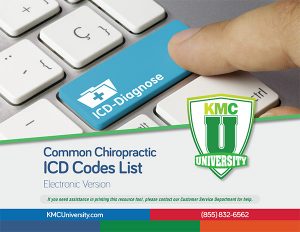Posted by Team KMCU on Aug 30, 2024
Time for Coding Updates
It is that time of year again. The updated codes for ICD-10 have rolled out. Time to locate the codes within your practice management software and update the data with the new code offerings after September 30, 2024. Be sure to inform all staff involved in charting, charge entry, or billing. Avoid taking the costly reactive approach to coding your services. The one where three months from now your claims are being denied because the most appropriate code was not utilized.
We recommend that you make it a habit to review changes, updates, and the Official Coding Guidelines. Sometimes we need a refresher on the codes we are already using to make sure we have taken into consideration all the instructional notes such as Excludes 1, Excludes 2, and Code Also. If you are a bit rusty on these terms, take some time to visit KMC University’s Documentation and Coding course titled ICD-10 Coding in Practice
Effective October 1, 2024
Although your clinic may utilize codes from a variety of chapters in the ICD-10-CM Code list, the majority of chiropractic clinics code come from Chapter 13- Musculoskeletal System & Connective Tissue. This year doctors have several NEW codes to choose from. Most are found in the M51 and M65 sections. If you do a great deal of extremity work, you will want to check out the M65- Synovitis and tenosynovitis codes. The current M65.9 code now has over 23 additional coding options that allow the doctor to report a specific location by adding a fifth and sixth character. This includes ankle, foot and shoulder. See example below:
| New Code | Code Description |
|---|---|
| M65.911 | Unspecified synovitis and tenosynovitis, right shoulder |
| M65.912 | Unspecified synovitis and tenosynovitis, left shoulder |
| M65.971 | Unspecified synovitis and tenosynovitis, right ankle and foot |
| M65.972 | Unspecified synovitis and tenosynovitis, left ankle and foot |
Disc Degeneration Specificity
Under the M51 section, in the thoracic and lumbar intervertebral disc disorders you will find additional codes listed. By appending a sixth character the provider can now report the specific area of involvement. The code descriptions allow the provider to report the absence or presence of lower extremity pain, discogenic back pain, and lumbar back pain.
| New Code | Code Description |
|---|---|
| M51.360 | Other intervertebral disc degeneration, lumbar region with discogenic back pain only |
| M51.361 | Other intervertebral disc degeneration, lumbar region with lower extremity pain only |
| M51.362 | Other intervertebral disc degeneration, lumbar region with discogenic back pain and lower extremity pain |
| M51.369 | Other intervertebral disc degeneration, lumbar region without mention of lumbar back pain or lower extremity pain |
| M51.370 | Other intervertebral disc degeneration, lumbosacral region with discogenic back pain only |
| M51.371 | Other intervertebral disc degeneration, lumbosacral region with lower extremity pain only |
| M51.372 | Other intervertebral disc degeneration, lumbosacral region with discogenic back pain and lower extremity pain |
| M51.379 | Other intervertebral disc degeneration, lumbosacral region without mention of lumbar back pain or lower extremity pain |
According to the ICD-10-CM Official Guidelines for Coding and Reporting (page 12/120), “Diagnosis codes are to be used and reported at their highest number of characters available and to the highest level of specificity documented in the medical record. ICD-10-CM diagnosis codes are composed of codes with 3, 4, 5, 6 or 7 characters. Codes with three characters are included in ICD-10-CM as the heading of a category of codes that may be further subdivided by the use of fourth and/or fifth characters and/or sixth characters, which provide greater detail. A three-character code is to be used only if it is not further subdivided. A code is invalid if it has not been coded to the full number of characters required for that code, including the 7th character, if applicable.” Detailed and accurate diagnosis reporting communicates a complete story to the payer about the patient’s condition. Do not skip this crucial step. Take time to review the added codes and include them when updating your software and coding protocols.
The Centers for Medicare and Medicaid Services (CMS) has posted the 2025 ICD-10-CM files, which contain information on the ICD-10-CM updates for FY 2025. KMC University library members can find these resources in the module titled ICD-10 Basics. This course includes the helpful Common Chiropractic Code List Support Tool and the conversation table summary of changes for 2024-25. The practice can simply download the conversation table, use the FIND option on the PDF and search for codes the provider currently uses and check for effective changes.








Comments on ICD-10 Coding Updates for September 30, 2024